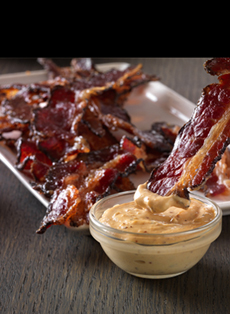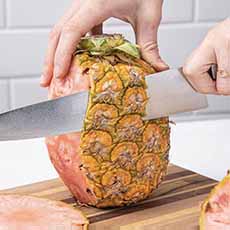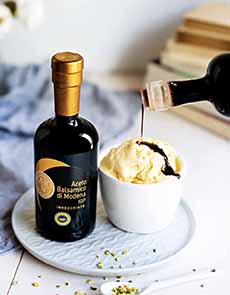|

[1] Schmacon and eggs (all photos © Schmacon).

[2] A Schmacon Cheeseburger (photo © Miguel Andrade | Unsplash).

[3] Use Schmacon wherever you’d use bacon. Here, Schmacon with a peanut butter dip. Now that’s snacking!

[4] Gotta love the Schmacon logo.

[5] Schmacon at Costco.
|
|
The creator of Schmacon Certified Angus Beef® Bacon, smoked and uncured, calls it “beef’s answer to bacon.”
For the many people would gladly exchange their pork bacon for flavorful beef bacon: Here it is, the best-tasting beef bacon out there.
Schmacon (that’s SHMAY-con, rhyming with bacon) looks like bacon and smells bacon; it cooks like bacon–preferably in the oven for maximum crispness (photo #1), although it can be cooked in a frying pan.
The resulting crisp strips of Schmacon tastes of beef instead of pork, but with the smoky, spicy spirit of bacon.
SCHMACON BENEFITS
For a similar meat experience:
A serving of Schmacon contains 30 calories, 2 g fat, and 60 mg sodium.
A serving of pork bacon averages 60-90 calories, 4.5-7 g fat, and 190-360 mg sodium.
Schmacon has no added nitrates or nitrites.
It is certified Halal.
More benefits:
Schmacon cooks in half the time of raw pork bacon.
It generates much less grease; and, as with bacon grease, you can use the grease to cook potatoes and eggs, make German potato salad, etc.
For everyone without a great kitchen exhaust fan: There’s no lingering smell of old bacon fat in the air.
Like bacon, Schmacon can be frozen; but we bet you’ll run through the package pretty quickly.
WHY SCHMACON IS SO GREAT
Meatier, lower in sodium, calories and fat, Schmacon is a much healthier bacon alternative. You get more meat and less fat.
And it’s not just more meat: It’s delicious meat.
Schmacon is not the first beef bacon on the market, but but it’s head and shoulders above the rest.
It was three years in development!
Most other beef bacon is manufactured with the same technique as pork bacon, but that made no sense to Schmacon CEO Howard Bender.
He started from scratch, testing different cuts of beef, spice blends and cooking processes until, three years later, he was satisfied.
We think the result is terrific, and so does the industry: The National Restaurant Association gave Schmacon its Food and Beverage Innovations Award.
WAYS TO USE SCHMACON
We don’t have to tell you how to use bacon, but…use it anywhere you’d use pork or turkey bacon.
Beyond Schmacon and eggs, and as a side to pancakes and waffles, we use it to make:
Bacon cheeseburgers and hot dogs
Bacon quiche
Bean and lentil dishes
BLTs
Brussels sprouts
Chowder
Hot bacon vinaigrette (with the leftover bacon grease)
“Larded” filet mignon or turkey breast
Spinach salad and wedge salad with blue cheese dressing
Surf and turf: bacon-wrapped scallops
FINALLY, AVAILABLE TO CONSUMERS NATIONWIDE
When we first wrote about Schmacon five years ago, it was new on the market and was focusing its efforts on selling bulk packages to restaurants and foodservice.
Not just in the U.S., either: Schmacon is way popular in the pork-free Middle East.
Now, it’s in America in certain regions of Costco, Walmart and other large chains. Here’s a store locator.
You can buy Schmacon online here.
But this killer beef bacon needs your help, so help spread the word that it exists.
Run out and buy some and tell your friends, so that the big retailers will keep it in stock.
Spread the word and you’ll enjoy Schmacon for a long, long time.
Discover more at Schmacon.com.
|


















